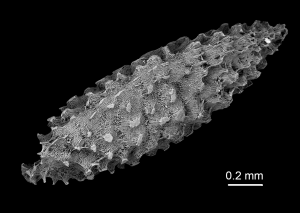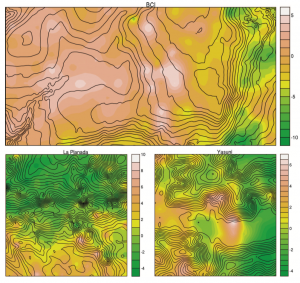In our lab we work on many aspects of forest ecology, but most projects are related to plant-soil or plant-fungal interactions. Below are some details on current research projects in the lab:
Seed-fungal interactions

SEM image of a Cecropia insignis seed
Natural enemies: herbivores, seed predators, and pathogens, are recognized to play a key role in shaping plant population and community dynamics. To date, most attention has been given to the fungal pathogens that promote plant diversity by imposing density and distance-dependent mortality on seedlings and saplings. However all life-stages and organs of plants interact with fungi – some act antagonistically, some are mutualist, and some interactions may be highly context-dependent, with interactions shifting according to host species and environment.
Our early work in the 1990s highlighted the importance of fungal pathogens as a source of mortality for seeds of pioneer tree species in the soil seed bank on Barro Colorado Island, Panama. Since then, we have explored the host specificity of fungal pathogens, distribution patterns, and taxonomic identity of seed associated fungi in much more detail. Most recently, we have highlighted ‘functional specificity’ of fungi — whereby individual fungal taxa can have antagonistic effects on one host species, but mutualistic effects on others. Our current work explores how seeds are defended against fungal pathogens, and the potential for plants to benefit from mutualistic seed-infecting fungi. These ideas were recently synthesized in our Annual Reviews paper.
Our on-going research is funded by an NSF grant 2023-2026 and continues a long-term collaboration with Profs. Betsy Arnold, Camilo Zalamea and Adam Davis
Effects of variation in soil nutrient availability on species distributions

Maps of variation in soil nutrient availability (PC axis 1) for three forest dynamics plots
Spatial variation in soil nutrient availability has been largely overlooked as a key determinant of tree species distributions – particularly in neotropical forests. We pioneered the production of soil nutrient maps to analyze species soils associations in large-scale forest dynamics plots. Our studies have shown that 30-50% of tree species show strong soil associations, and that soils and topography account for similar amounts of variation in tree community composition.
Our current work takes advantage of detailed analyses of soil chemical and physical properties across 1-hectare forest dynamics plots that we have established at the Fortuna Forest Reserve and Volcan Baru National Park in western Panama. We have used our combined soils and plot data, transplant experiments, and functional trait analyses to examine the distributions of ferns, palms and tree species. We also manage the Fortuna NITROF long-term forest fertilization experiment, in which nitrogen has been added to permanent 40×40 m plots since 2007. Most recently, we have started to examine how soil characteristics are related to the mycorrhizal status of tree communities, and the potential for mycorrhizally mediated plant-soil feedbacks to generate monodominant forests.
Microbial community assembly and wood decay processes
Wood nutrient traits remain poorly explored by ecologists, yet are associated with species distribution patterns across soil nutrient gradients, and potentially represent stores of resources that can be reallocated to support growth and reproduction. Our work has shown that wood nutrient concentrations are highly variable among species. In addition to examining the dynamics of wood nutrient storage in live trees we are also exploring the consequences of variability in wood and bark nutrient concentrations for rates of wood decay and for the assembly of microbial communities (fungi, bacteria and archaea) in both aquatic and terrestrial ecosystems. We have on-going wood decomposition experiments at Fortuna, and contribute to global wood block decomposition studies with collaborators around the world.

Decay of wood incubated in five habitats on Coiba Island. Holes are made by shipworms.

